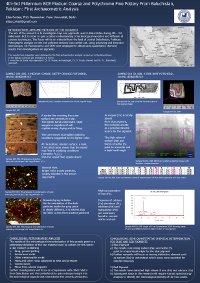| Author | Elisa Cortesi |
| Title | 3rd Millennium BCE Orange Medium Coarse and Polychrome Fine Pottery from Central Baluchistan: First Archaeometric Analysis |
Abstract
The aim of the research is to investigate clays and pigments used in Baluchistan during the early 3rd millennium BCE in order to gain a better understanding of technological evolution, sharing and diffusion of ceramic techniques. In the facilities of the ISCR in Rome, petrographic analysis on thin and polished sections was carried out, using polarizing and binocular microscopes. XR Fluorescence and SEM were employed to obtain semi-quantitative chemical results from investigations on pigments. The mineralogical characterization of pastes provides a preliminary definition of the raw material used by local potters. Further investigations will focus on comparisons with other fabrics from Baluchistan and the borderlands. Preliminary SEM and XR Fluorescence analysis point to a possible identification of minerals present in blue, red and yellow pigments. Future research will concentrate on tracing distinctive elements to understand which areas were used for the exploitation of natural resources. Furthermore Raman spectroscopy analysis will be required to establish a precise mineralogical identity of the oxides. In this poster, I present the first results from samples collected in Central Baluchistan.
